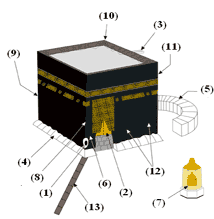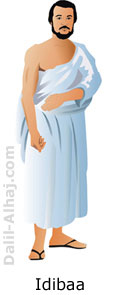Al Tawaf:
-
 At
the beginning of Tawaf, it is recommended for the pilgrim to
face the Ka‘bah such that the Black Stone is on his right. Then
he moves to position himself before the Black Stone and intends
Tawaf (either the Tawaf of ‘Umrah or Tawaf Al-Qudum). At
the beginning of Tawaf, it is recommended for the pilgrim to
face the Ka‘bah such that the Black Stone is on his right. Then
he moves to position himself before the Black Stone and intends
Tawaf (either the Tawaf of ‘Umrah or Tawaf Al-Qudum).
- He starts from the brown marble line saying: (Bismillah,
Allahu Akbar) “In the name of Allah, Allah is the Greatest.
O Allah! Having faith in You, confirming the truthfulness of
Your Holy Book, fulfilling Your promise and following the Sunnah
of Your Prophet (peace be upon him)”.
- The pilgrim touches the Black Stone and kisses it if possible.
- If it is too difficult to kiss it, he touches it with his
right hand and kisses his hand.
- If that isn’t possible he stands facing the Black Stone
and points to it with his hand once while saying: “Bismillah,
Allahu Akbar” (in the name of Allah, Allah is the Greatest).
Then he starts Al-Tawaf.
How to point correctly to the Ka‘bah?
The pilgrim raises his hands in parallel with his shoulders
making the inner part of his hands (palms) directed towards
the Black Stone and he points to the Ka‘bah with his hands
one time only. |
-
 Tawaf
is performed for seven rounds and it is Sunnah to do Ramal,
by moving quickly in the first three rounds, and Idibaa, by
throwing the upper sheet of the Ihram dress over the left shoulder
and exposing the right shoulder (Idibaa - for males only) during
all rounds. This is the case only for the Tawaf, which is followed
by Sa‘y between Safa and Marwa. Tawaf
is performed for seven rounds and it is Sunnah to do Ramal,
by moving quickly in the first three rounds, and Idibaa, by
throwing the upper sheet of the Ihram dress over the left shoulder
and exposing the right shoulder (Idibaa - for males only) during
all rounds. This is the case only for the Tawaf, which is followed
by Sa‘y between Safa and Marwa.
TIPS
Ramal: is to go round the Ka‘bah at a jogging pace with short steps
without jumping or running.
 Idibaa:
means exposing the right shoulder of a pilgrim by putting the upper
sheet of Ihram dress under his right armpit and covering his left
shoulder. Idibaa:
means exposing the right shoulder of a pilgrim by putting the upper
sheet of Ihram dress under his right armpit and covering his left
shoulder.
Ramal and Idibaa are only for men and are practiced only in the
Tawaf which is followed by Sa‘y. So whenever a pilgrim finishes
Tawaf he covers his shoulders.
The pilgrim (Hajj) recites at the door of the Ka‘bah:
“O Allah! The House is Yours, and the Haram is Yours, and the peace
is Yours, and this is the place of he who seeks Your protection”.
- He says at the Iraqi Corner:
“O Allah! I seek refuge in You from doubt and from polytheism,
from discord, hypocrisy, ill-manners, and calamity in property,
family and children”.
- He says between the Shami Corner and the Yamani Corner:
“O Allah! Make my Hajj an accepted Hajj, my effort accepted
and recognized, my sin pardoned, my deeds accepted and grant
me a trade that will never fail, You are the Exalted in might,
The Oft-Forgiving”.
- Istilam (facing) the Yamani is desirable whenever the pilgrim
passes by it during Tawaf, by touching the Corner with his palms
or with his right hand. If this is not possible, he should point
towards it. Du‘a (invocation) is recommended at the Yamani Corner
because it is surely accepted since there are seventy thousand
angels there who say “Ameen”.
| In order for the Tawaf to be correct, a pilgrim must
stop completely at the Yamani Corner. |
-
The pilgrim recites between the Yamani Corner
and the Black Stone:
“Our Lord, give us in this world [that which is] good and in
the Hereafter [that which is] good and protect us from the punishment
of the Fire.”
“O Allah! Save me from disbelief, want and disgraceful
situations in this world and in the Hereafter”.
- He invokes often in the first three rounds: “O Allah! Make
my Hajj an accepted Hajj, forgive my sins accept and recognize
my effort”.
- He recites in the other four rounds: “O Allah! Forgive and
grant us mercy, pardon and favor, excuse us for what You know
of us, You are the Most Powerful, the Most Generous ”.
The pilgrim makes continuous invocations, asking for the good
of this world and the good of the Hereafter.
- At the end of the Tawaf, the pilgrim touches and kisses
the Black Stone or he points at it with his palms and at each
time he passes in front of it during Tawaf.
The Two Rak‘ahs of Tawaf:
After completing Tawaf, the pilgrim prays two rak‘ahs of Tawaf
behind Maqam Ibrahim (the standing place of Ibrahim) (may peace
be upon him) even at the end of the Haram, or in any place in the
Haram it is permissible in case the Haram is over-crowded.
In the first rak‘ah he recites the Surah of “Al Kafiroon”, and
in the second rak‘ah he recites Surah “Al Ikhlas” … after “Al Fatiha”.
Allah says:
(And take,
[O believers], from the standing place of Abraham a place of prayer).
He invokes after the prayer: “O Allah! You invited Your slaves
to Your Sacred House, and I came in response to Your call begging
for Your Mercy and beseeching Your Content, and You have granted
me my quest, so forgive me. You are over all things Competent”.
Prophet Muhammad (peace be upon him) said: “The Tawaf around
Ka‘bah is a prayer, except that Allah has allowed speech therein,
so who utters a word shouldn’t say but good ”. Therefore, it is
stipulated in Tawaf to be in the state of Tahara (Purity) from ritual
impurity and covering private parts (‘Auwra).
| In case the Tawaf is interrupted either for Salah (prayer)
or to renew wudu’ (ablution), the pilgrim continues Tawaf
from the beginning of the round he was performing. |
|